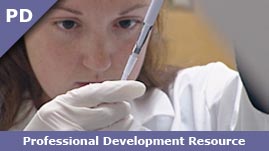Teachers' Domain - Digital Media for the Classroom and Professional Development
User: Preview


Source: Getting Results: "Working with Non-traditional Learners"
This media asset is excerpted from Getting Results: "Working with Non-traditional Learners."
In this professional development video excerpted from Getting Results, diverse learners study biotechnology at a technical college. The instructor and her students describe the students’ unique backgrounds: an older adult learner with lengthy professional experience in the computer industry, an immigrant student with a master’s degree in microbiology from her native country, and a younger student who had gone as far as he could in his job. The instructor states that examining these diverse backgrounds helps her make the most of each individual’s contribution, particularly in the lab where students work as a team.
When students are comfortable in the classroom, they learn better. Instructors can help students get comfortable by learning about them and their backgrounds.
In a college setting, "non-traditional learners" are students outside the typical college-aged cohort (18-24 year olds). They might be employed but seeking to upgrade their skills, or unemployed due to an economic downturn (as referred to in the video). They might be immigrants or be otherwise new to the workforce.
Learners in community colleges are frequently older adults with workplace experience. Many have different learning needs than younger students who have come straight out of high school. They might have limited technology skills, but extensive industry knowledge or advanced degrees. By tapping into these students’ valuable knowledge, the instructor helps them make unique contributions to the group.
Students also have different ways of learning. Some prefer a hands-on approach, while others greatly benefit from listening and lectures. By getting to know each student’s characteristics and backgrounds, instructors can create a classroom environment that leverages diversity. In such an environment, all students have the chance to make the most of their learning.
 Loading Standards
Loading Standards